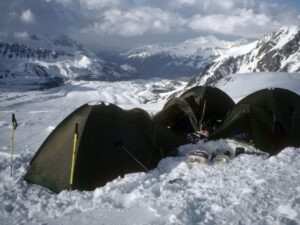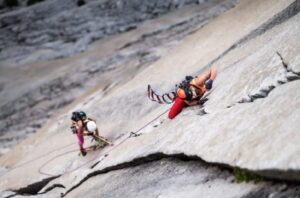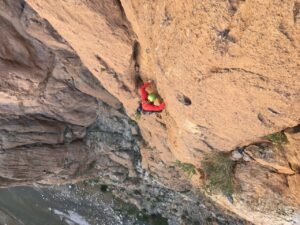[Article Updated with new information on 17th February 2019]
Just shy of 700km long, Siberia’s Lake Baikal has become an increasingly popular destination for cold-weather travellers. Temperatures on the world’s largest frozen lake can drop to the minus 40s, though this is rare in late winter, and visitors can face strong winds and open water. However, its ease of access and lack of more extreme temperatures and objective danger make it an ideal polar training ground — or as we are now seeing with speed record attempts, a sporting arena.
This February-March, a few will try to make unsupported lengthwise traverses of the lake (circa 640km). This includes both soloists and teams racing for the speed record.

The glassy surface of Lake Baikal. It’s not like this everywhere, or every year, but it’s wise to bring ice screws and/or nails and a hammer. Photo: Scott Gilmour/weatherised.com
Soloists
On February 11, Gina Johansen of Sweden set off from the southern starting point of Kultuk to try to hurry across the lake in 12 days — a speed record, if successful. Even if she finishes more slowly, she can still become the first Swede to do the entire distance solo. Johansen lives in the Norwegian arctic region of Finnmark: Last year, she skied 2,000km alone from Nordkapp in Norway to Salen in Sweden. Johansen swiftly covered 90km in her first two days, although she has had to take a brief pit stop on land due to a fuel leak. You can follow her live tracker here.

All smiles, at least in training. Photo: Gina Johansen
In the first week of March, three Brits launch their own solo crossings. The experienced Rosie Stancer aims for a full south-to-north traverse. Stancer has skied to both Poles, including the Hercules Inlet-South Pole route, and she aborted just one degree short of a full solo North Pole expedition. Joining her, on their own solitary treks, are Phil Sturgeon and Mike Laird. Last year, Sturgeon completed a 640km partial crossing of Baikal with a friend. Mike Laird, meanwhile, will start at the north end and ski south. Laird has previously taken part in a guided 600km sled expedition in the Canadian High Arctic and cycled 3,000km in Australia. Finally, Spaniard Jose Trejo will trek a 450km partial route from midway to the southern tip. Trejo has spent nine years working on Greenland expedition logistics and has sailed more than 25,000km in arctic waters.
Teams
Possibly the first team on the ice this season were three Spanish women: Chus Lago, Veronica Romero and Rocio Garcia. They started in Kultuk on February 1 and are over halfway toward a full crossing (end point unknown). On February 18, Dan Born and Ladislav Smrz from the Czech Republic will leave Sludyanka to complete a full crossing in 19 days. Born is a product manager in Prague and Smrz a sled dog guide in Norway. If successful, Born may well be be the youngest to complete a full crossing.
American Rick Garrigan and Polish endurance athlete Alijca Barahona will set off in late February to run south to north in a projected 15 days. A week later, Scott Gilmour and Michael Stevenson will seek to upgrade their speed record of 12 days, 21 hours and 13 minutes from last year. Gilmour is a polar guide based in Norway, while Stevenson works in mountain rescue in the UK.
Meanwhile, Philip Hayday-Brown, a polar colleague of Gilmour’s, will join Jonathan Zeffert and Alex Buckland on a recce trip halfway along the length of the lake.

The current speed record holders: Michael Stevenson, Scott Gilmour and Rob Trigwell. Photo: Scott Gilmour/weatherised.com
ExplorersWeb’s list of previous Lake Baikal expeditions can be found here.
Related Links
Baikal an Ideal First Expedition for Winter Haulers






